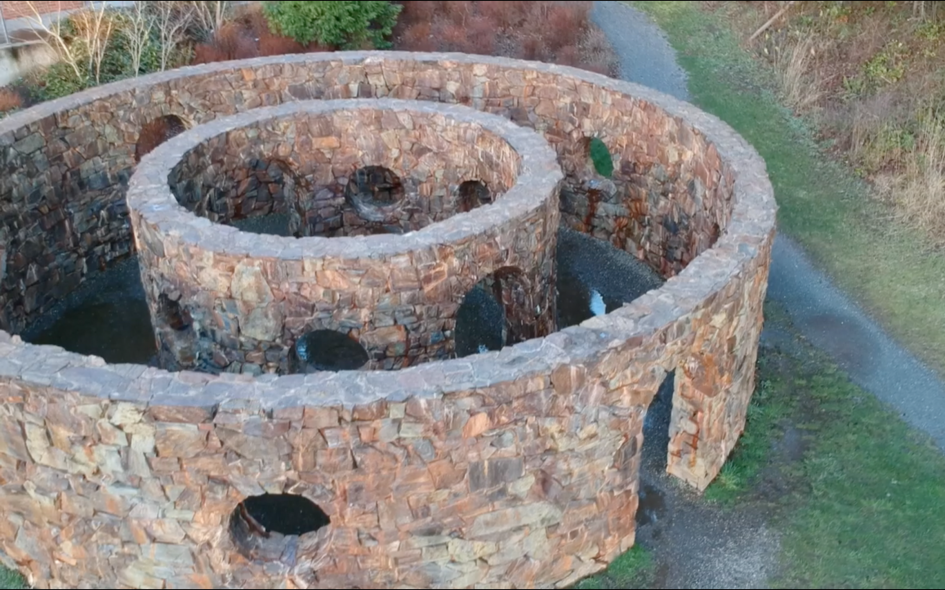About the Piece
Nancy Holt’s Rock Rings is a large stone sculpture that consists of one large stone ring about 10 feet tall, and then an internal ring both have several holes within that represent the cardinal directions North, South, East, West, and Southeast and so on to describe the directions on a compass. It was also made with the north star and nature surrounding it in mind to bring attention to the cyclical time of the universe. One of Nancy Holt’s purposes behind this piece is to have the art that is directly linked to the location where it is placed; this is one of the first times this type of work is made by a woman. Another purpose of this piece is for interaction; it is meant for both the viewer and the landscape to interact with it. At first glance, a viewer would not be able to tell what is on within the piece, which draws the viewer in and forces them to engage and interact with the piece to understand what is going on. This piece is both visually intriguing and captivating because upon first glance this is a very simplistic sculpture that may not have any more to it than the outer ring, but until the viewer goes into the sculpture and experiences it, they would never know the intricacies of the full piece.
The Artist
Nancy Holt fell in love with the Northwest describing it as a museum without walls. She creates pieces that can connect with the land it in on and the area that surrounds it. Specifically, she is known for pieces such as Sun Tunnels (1977- 1978) which frame the sun as it sets. Nancy Holt’s pieces are made in a leave-no-trace way that makes them feel as though they are barely there or as if they are meant to be apart of the landscape. She aims to create a deep connection between the environment and the viewer by making her pieces about where they are located. She often states how she wants to show people the cyclical time of the universe, this a common theme in her works. Her pieces are made to deal with the issues people have with time and place. This is why almost all of her pieces contain elements of time, human geographic or celestial.
In the 20th-century land art was mainly male-dominated field which is why even though she was one of the most prominent land artists at the time she is less well recognized. While another artist at this time focused on competing with one another to create the most extensive or most impactful work, Holt concentrated on integrating her art into the landscape. This is why she insisted on experiencing her work in person rather than through photographs or video. In the 1960s the land art movement began and grew alongside the environmental movement. This change is what inspired Nancy Holt to create pieces promoting ecological activism. Holt focused on the connection between land art and eco-activism, and she is one of the earliest artists we see putting this kind of meaning behind her pieces.
Contributors
Phoebe Hafertepen- Research, Editing and Organization of the blog, and Audio for video
Walker Smith- Photography, Filming, and Editing of video
Amaya Vergara- Audio script
Works Cited
Blumberg, Naomi, and Sonia Chakrabarty. “Nancy Holt.” Encyclopædia Britannica, Encyclopædia Britannica, Inc., 24 Nov. 2016, www.britannica.com/biography/Nancy-Holt.
History.com Staff. “The 1970s.” History.com, A&E Television Networks, 2010, www.history.com/topics/1970s.
Hummer, Rebecca, and Bradley Hoefel. “React. Research. Execute!” React Research Execute, wp.wwu.edu/wwuart109/category/southcampus1/holt/.
Kennedy, Randy. “Nancy Holt, Outdoor Artist, Dies at 75.” The New York Times, The New York Times, 12 Feb. 2014, www.nytimes.com/2014/02/12/arts/design/nancy-holt-outdoor-artist-dies-at-75.html?module=ArrowsNav&contentCollection=Art%2B%26%2BDesign&action=keypress®ion=FixedLeft&pgtype=article.
“Nancy Holt Biography, Art, and Analysis of Works.” The Art Story, www.theartstory.org/artist-holt-nancy.htm.

Leave a Reply